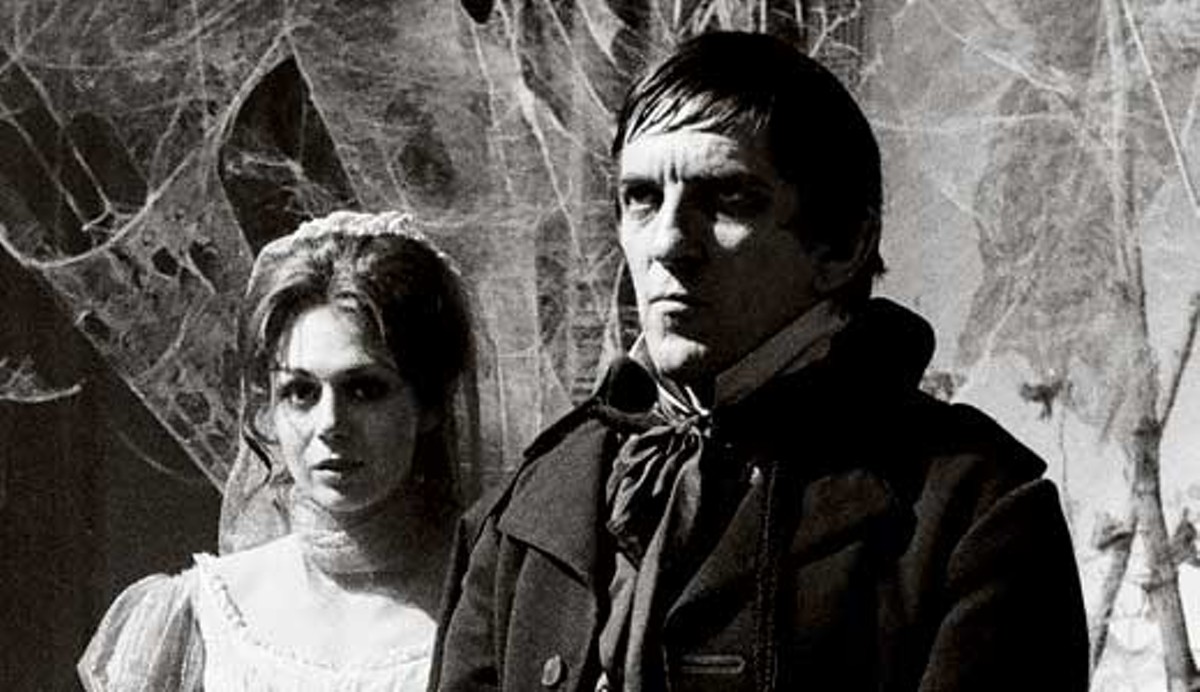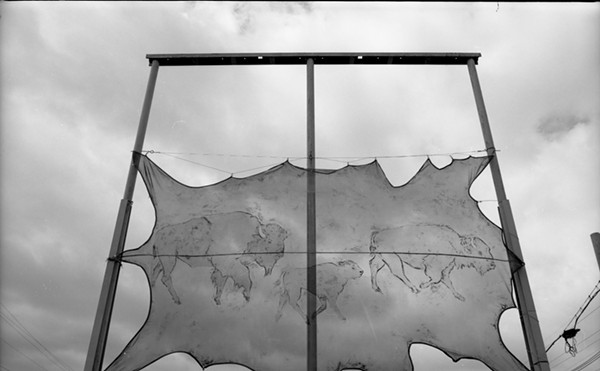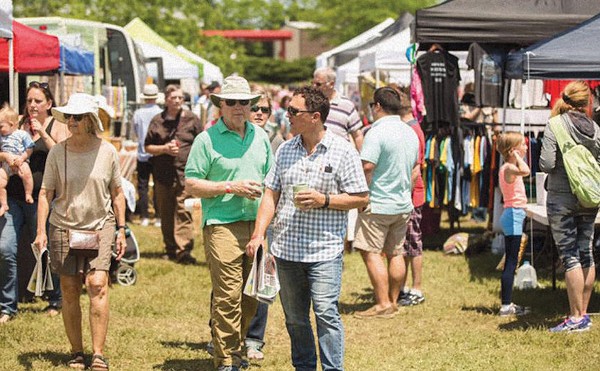My name is Victoria Winters. My journey is beginning. A journey that I hope will open the doors of life to me and link my past with my future. A journey that will bring me to a strange and dark place …” —Episode 1, 1966
The best journeys always traverse strange and dark places. And every journey’s end marks the beginning of the next, turning and cycling until you eventually find yourself home yet again. Our universe is full of such spirals, and they all seem to pass through Kentucky. This particular journey begins for me behind the doors of a neighbor’s house, in their dimly lit basement, where (surrounded by girls, oh, boy!) I tune in to watch “Dark Shadows,” the legendary “vampire soap opera.” It is 1970, and I am 16 years old.
Out of breath from running down Woodrow Hill behind Moore High with an armload of books, my eyes adjust to the gloom; the TV, a tomb-shaped slab, squats on the floor, festooned with antennae like a big fat bug. There is no DVD, there is no VHS, no TiVo, no reruns. If I miss this episode, there is no chance of ever seeing it again, which makes each day’s viewing a communal event. And, yes, we all realize the show is terrible — from the wild melodrama to the ham acting to the cheezy sets to the unfathomable plots to the cheap live-on-tape, in-one-take recordings, visible microphones and all. This is bad TV, and that just makes us love it all the more. Thirty minutes per episode, five times a week, this scene is repeated all across America.
We didn’t know it at the time, but we were pawns in a game that would forever change American society. Of course, the 1960s had been filled with revolutionary events: Vietnam, Woodstock, and the first manned moon landing, to name just a few. But “Dark Shadows,” for me at least, marked a tipping point — that moment when the world recognized me and my generation, sending ripples far into an unpredictable future.
“Time is a rushing, howling wind that rages past me, withering me in a single, relentless blast, and then continues on.” —Barnabas Collins
Prior to this time, moms — housewives — controlled nearly all of the nation’s spending: dads worked, moms shopped, kids and teens stayed out of the way. If you tuned in to any of the three — count ’em, three — daytime TV channels, you would only see shows and products aimed at moms. It was these commercials, largely for cleaning products, that gave the wildly successful “adult daytime dramas” their derisive nickname of “soap opera,” and the last of the day’s soaps always ended before 3 p.m., lest the kiddies see them. Until “Dark Shadows.”
Springing from the mind of Dan Curtis in 1966, inspired by his dream of a mysterious woman on a train, the plan was to produce just another soaper, albeit with a dark, costumed Gothic feel, wrapped in smoke and cobwebs. Shot partly on location (a rarity), in black-and-white (to save money), it aired at the unheard of time of 4 p.m. on ABC. This timeslot was Curtis’ stroke of genius, because it meant kids could watch after school. No one had ever considered aiming a soap at kids/teens before — remember, they had no money — but Curtis was convinced moms and kids would watch together, opening the door to new advertising revenue.
Before we go on, it’s important to note that the show’s “bible” — its long-term story arc, written to pitch the show to the networks — had no supernatural elements: An orphan woman, Victoria Winters (actress Alexandra Moltke), seeking her past, becomes a governess at Collinwood, an ages-old manor house in Maine. To be frank, it was slow; Curtis compensated by cranking up the melodrama. Ratings continued to be less than spectacular. And then the script mentioned ghosts.
“Any friend of a ghost is a friend of David’s.” —Carolyn Collins Stoddard Hawkes, about David Collins
At first the ghosts were unseen, yet responsible for sending certain characters into hysteria and madness. The audience ate it up, so more backstory was ordered: The Collins bloodline was steeped in insanity; the ancient pile of Collinwood had witnessed horrific acts of lust and cruelty and revenge; there were whispered tales of eldritch, eternal monsters who rose and fell in fiery rituals. Finally, an actual ghost appeared on the screen, the ectoplasmic form of Josette Collins (Kathryn Leigh Scott).
The response was immediate: The ghost scene was mentioned in the newspaper. More people tuned in, including teens. Advertisers began to show interest, renewing the show for a second season. And it was in that season that “Dark Shadows” found its heart in the character of Barnabas Collins, the reluctant vampire played by Jonathan Frid, who burst from his coffin during a botched grave robbery, sending America’s teens running home from school to catch the action.
And what action! Victoria travels back in time! The vampire seeks a cure from a mad doctor (played by respected avant-garde actress Grayson Hall), resulting in grotesque disfigurement! A rushing torrent of new advertisers pay to upgrade the show to garish color!
As the show grew in popularity, the plotlines became ever more bizarre, introducing werewolves, zombies, Frankenstein-built monsters, witches, warlocks, time travel and parallel universes to the mix. And should any of it begin to make sense, the writers could simply walk one character into some previously unseen hallway and — presto! — the old plot was forgotten, something new began, and the actors now all portrayed different characters. Teens couldn’t get enough; moms, however, blanched. But for every mom who left, there were handfuls of teens to take her place, so without the benefit of Facebook, Twitter or blogs, the word spread and ratings climbed.
By the tail end of the ’60s, “Dark Shadows” had become a daytime teen cult TV phenomenon, arguably the first ever. But where was the money coming from? Who was interested in sponsoring a teen soap opera about a vampire? Remember: We teens had almost zero buying power, and even if we had money, there were no iPods to buy, no video games, no wireless minutes. Only the music industry had successfully made a buck off of teens, but with thousands of AM radio stations at their command, they rarely stooped to TV ads.
And that’s where “Dark Shadows” crossed into the bluegrass. Tobacco companies began to shovel heaps of money behind this growing phenomenon. And lest you think that the notion of cigarette ads aimed at kids and teens is a modern myth, tobacco companies were already sponsoring “The Jimmy Dean Show,” “The Twilight Zone,” “The Outer Limits,” “The Dick Van Dyke Show,” “Red Skelton,” “The Beverly Hillbillies” and “McHale’s Navy,” among others — shows whose audiences were at least 30 percent young people, a group that consumed 26 tobacco ads a week, despite the very limited TV viewing of the day*. “Dark Shadows” delivered exactly the audience they were looking for.
“Well, Jed, Miss Hathaway, she said the best Christmas present that we could send to our kinfolk back home would be a carton of Winstons.” —Granny Clampett, early 1960s advertisement
We teens who watched “Dark Shadows” were already cool, and the commercials told us it was even cooler to smoke. Cigarette use increased within the show itself: one recent blogger, watching Episode 306 from mid-Season 2 remarked, “Did ‘Dark Shadows’ just pick up a cigarette sponsor? All of a sudden, everyone’s smoking like dragons. Smoke … is still roiling through the closing credits!”* Then several of the show’s actors became tobacco pitchmen: Donald Briscoe, who played Tom Jennings, among others, hawked Camels, while Geoffrey Scott, “Sky Rumson” (and the president in 2003’s “Hulk”), proffered Kools. Hey, everyone was doing it …
To give you some perspective on how pervasive these tobacco ads were: In 1970, you could drive a brand-new AMC Gremlin off the lot for $1,879. That same year, the tobacco companies spent $200 million on TV advertising — $1.2 billion in today’s dollars. But these deep pockets locked other advertisers out of the market. They were just beginning to see the value in advertising to teens, but cigarette money kept the advertising rates far outside of what they could afford to spend. We teens, for our part, went looking for part-time jobs. There were finally things out there we wanted to buy — like cigarettes!
By 1970, “Dark Shadows” had become the de facto symbol of a burgeoning new generation. We had our own interests, we smoked openly and were becoming a force in the marketplace. Many of us emulated or identified with the tortured “Dark Shadows” characters. (This was, arguably, the origin of today’s Goth culture, though that term wouldn’t be applied for a generation.) Clichés formed, then clubs, then conventions popped up; there were personal appearances, comic books, fan magazines and board games — one with glow-in-the-dark teeth! “Quentin’s Theme” became a top AM hit, and there was a stampede on Marilyn Ross “Dark Shadows” paperbacks.
But apart from the creature-feature fun, what really drove the popularity was that the show had evolved from a soap to become a spoof of soaps. It was thumbing its nose at all the titillating, provocative, bodice-ripping, incestuously salacious hogwash that filled the average adult drama, and in doing so, let the teen viewers figuratively thumb their noses at the conventions of the day — it was “The Colbert Report” of its day. Of course, we teens didn’t recognize all this at the time, but we knew that it pissed off Mom and Dad, and that was enough. This was 1970! Those damn ’60s were over, and it was our turn to rebel. But our day ended quickly.
It all came tumbling down on April 1, 1970, when Richard Nixon signed legislation officially banning all cigarette ads on television and radio. The money evaporated overnight and long-running TV shows followed quickly. By the time the last TV cigarette commercial aired on “The Tonight Show,” Jan. 1, 1971, many soaps had already been replaced by much-cheaper-to-produce game shows. “Dark Shadows” gave up the ghost on April 2 of that year after an astounding 1,225 episodes. A shallow generation mourned its first heartbreak.
“The Collins blood always had a rather persistent strength.” —Barnabas, 1967
But, much like many of the show’s characters, “Dark Shadows” refused to stay dead. Later that year, “House of Dark Shadows” appeared at the theaters, a bloodier, sexier, more violent take on the Barnabas myth with much of the original cast. It was a hit, spawning a sequel. But the sequel failed: Jonathan Frid had moved on, and the social glue that had made the TV show a hit had dispersed. And so “Dark Shadows” became a second-class commodity, seen only in spotty syndicated reruns, awaiting a new generation of viewers — or maybe Victoria Winters — to find it again.
And that’s just what happened in 1982. Alexandra Moltke, the still-beautiful, dark-haired actress who first portrayed Victoria Winters, now sat on the witness stand in the lurid, real-life trial of Claus von Bulow. She had been his mistress, demanding that he divorce his wife. Now the wife, Sunny von Bulow, lay in a mysterious, irreversible coma, possibly the result of an insulin injection by Claus. Even Dan Curtis couldn’t have dreamed up such melodrama, and the trial’s sensationalism renewed interest in “Dark Shadows,” causing the syndication to spread like wildfire across the United States. In Louisville, these reruns appeared on PBS’ WKPC-15, where a small but rabid group of fans — most too young to have seen the original broadcasts — not only recreated my basement memory for themselves, but did me one better: They held their own “Dark Shadows” conventions.
Jonathan Frid appeared at the first one in 1987 at the Seelbach Hotel with his former co-star Roger Davis (Peter Bradford, Charles Delaware Tate, et al). But Davis wasn’t really in town for the convention: He was a Kentucky native who had come to Louisville in 1979 to develop the 1400 Willow high-rise near Cherokee Park and begin renovation on the shuddered — and very haunted — Seelbach. A second, less successful of these “Dark Shadows Fellowship Fairs” followed in 1988. And Frid wasn’t really here for the 1987 fair either. He came to launch a new road-show production of “Arsenic and Old Lace” for which he would earn high acclaim. As I said, all roads lead through Kentucky.
The local reruns ended in 1990 when the rights were purchased by the SciFi Channel (back when it served as a beacon of what then-early cable TV could achieve), showing them anew on cable and exporting the show for the first time to the UK. In Britain, it rivaled “Dr. Who” in geek popularity; outside, “Dark Shadows” mania swept Europe.
Today, with the show having been seen in the ’60s, ’70s, ’80s and ’90s, throughout much of the world, its fans have grown and prospered, many of their lives influenced by their love of “Dark Shadows” and all the dark and strange journeys within. Later this week, crazed movie director Tim Burton will release his own homage: a “Dark Shadows” movie. Born in 1958, he was a rabid fan of the show during its original broadcasts and freely credits the show for kindling his lifelong fascination with dark and spooky tales. And like any true fan, he freely admits with a chuckle that, “I think you could say it was actually awful.” Even his star, Owensboro native Johnny Depp (born 1963), remembers, “It was a real thing for me, I had to watch it, and it was tough because you’d miss the beginning — it started at like 3 p.m., but that’s when we got out of school. And then it moved later because all the kids wrote in letters. When you met someone who knew the show and loved it, there was an instant connection.”
But this is hardly the first movie to pick up Barnabas’ “vampire with a tortured soul” narrative. There have been thousands of vampire movies made in the last 50 years, so many that few today recognize the “Dark Shadows” connection. Most recently we have Stephenie Meyer’s “Twilight” saga with a vampire and a werewolf competing for the same mortal woman. Yep, “Dark Shadows” did it first.
On TV, Kevin Williamson, creator of “Scream,” “I Know What You Did Last Summer,” the underrated “The Faculty,” and CW’s “Vampire Diaries,” has also turned his “Dark Shadows” obsession into a reality, stating, “I always wanted to reboot ‘Dark Shadows’ ... that was the goal, to do a show like ‘Dark Shadows.’ ‘Vampire Diaries’ is my version of that.” Previously, Joss Whedon led the way in his legendary “Buffy The Vampire Slayer,” planting his vampire in sunny SoCal, and later spinning off “Angel” to continue the fun. And while “Fringe” creator J.J. Abrams has never commented on the subject, you can’t help but notice how many of his projects — from “Lost” to “Fringe” to “Alcatraz” — are rife with the same inexplicable lurches through time and alternate space that made “Dark Shadows” such a wonderfully confusing jumble of memories.
And so we have reached today: the end of our journey — or the beginning, if you prefer. We have seen “Dark Shadows” dart in and out of history, weaving new fans and old in a tattered tapestry of fantasy and imagination. Unfortunately, not all of us have survived the trip. In a sad footnote, actor Jonathan Frid, our beloved Barnabas, died last month at the age of 87, on Friday the 13th.
But what about the future? Who can say how many others have already been inspired by the continuing “Dark Shadows” legacy? Will those people go out on their own dark and strange journeys, creating new books, movies, TV shows or other forms of entertainment not yet imagined? Yes, the history of Collinwood is only beginning; and to prove it, MPI Media has just released, for the first time, a limited-edition DVD set of the entire original series: all 1,225 episodes on 131 disks in a coffin-shaped box with lots of great bonus goodies.
Oh, did I say “first time”? Actually, it was first released in April, but that pressing sold out before the first box ever hit the street — home video has never seen such a thing happen before. So I suggest you get yours quickly. Your journey is about to start.
*References: 1) “Exposure of U.S. Youth to Cigarette Television Advertising in the 1960s” by R.W. Pollay. 2) “The Drawing Room #19: Episodes 301-305.” Special thanks to Dave Conover and Daniela Sapkar for their generous assistance in this article.






